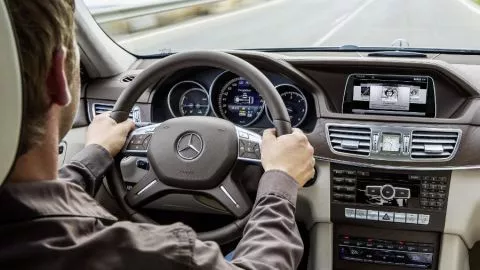holding the steering wheel- ways of holding the steering wheel- postural vices car-steering wheel
Contenido del artículo
Does the way you hold the steering wheel put your safety at risk?
Aprender a coger el volante correctamente no entraña grandes dificultades. Es una de las primera lecciones de la autoescuela: manos a las 10 y 10. No obstante, la costumbre y las manías pueden hacer que adoptemos vicios posturales. La manera de coger el volante, por nimia que parezca, pone en riesgo la seguridad de nuestra conducción. Además, también puede ocasionarnos un buen disgusto para nuestro bolsillo.
 The General Traffic Regulations make it very clear: the driver must maintain a safe distance from the road. right position on the move. This includes, of course, the way you hold the steering wheel. Watch your hands! If the agents detect the faults we will explain below, you could receive a hefty fine. Driving like a professional is not that complicated.
The General Traffic Regulations make it very clear: the driver must maintain a safe distance from the road. right position on the move. This includes, of course, the way you hold the steering wheel. Watch your hands! If the agents detect the faults we will explain below, you could receive a hefty fine. Driving like a professional is not that complicated.
The way we hold the steering wheel of our car is essential to avoid possible accidents. The Dirección General de Tráfico (DGT) indicates that the only regulatory position is to place the hands at 10 and 10 o' clock if we imagine that the steering wheel is an analog clock. They also indicate that the arms must be flexed. However, it also accepts quarter past 9 as the correct position.
Why take the wheel at 10:10?
The reason behind this decision is not arbitrary. If it is taught this way in driving schools, it is because it is the ideal position for making a turn. In this way, the turn is executed efficiently and instantaneously. The hands must change direction without colliding when crossing each other.
On the other hand, having the arms flexed is a way to minimize injuries in the event of a crash. This is due to the fact that postural vices of tension in the arms not only do not lessen the impact, but can even cause their fracture.
But we are human. And this means that no matter how clear the rules are, sometimes, when spending so many hours behind the wheel , postural vices are acquired unconsciously. For this reason, we are going to clarify which are the most vicious ways to take the wheel. This way you will be able to identify them and correct them before receiving a sanction.
The problem of the following ways of holding the steering wheel is that they prevent the proper reaction to unforeseen events. Sometimes, even these postural vices have their own popular denomination that defines the drivers who present them.
Tell me how you hold the steering wheel and I will tell you what kind of driver you are.
The relaxed
The relaxed driver holds the steering wheel with both hands at the bottom. Normally this posture is found among drivers on routine journeys. In general, on uncomplicated highways or freeways at constant speeds.
The intense
In this case, the driver places the hands practically together on the highest part of the steering wheel. This results in a forward leaning posture that separates the back from the seat. The consequences are harmful for vision and reaction on the road.
The dishwasher
The movies have brought us this postural vice on numerous occasions. The most reckless drivers of the Fast & Furious saga wear this cool posture. It consists of turning the steering wheel with the palm of the hand. The danger of this kind of steering wheel DJ is that there is no real grip. The steering wheel can slip out of your hands at any time.
The pilot
Watching Formula 1 races takes its toll. The pilot driver is the one who grips the steering wheel as if his life depended on it. He takes every corner by leaning his body to supposedly make counterweight. But the car, obviously, does not need these tricks and all that results is a reduction in visibility.
The levers
A classic if ever there was one. The sports car driver drives with one hand on the steering wheel and the other on the gearshift. This is one of the most widespread postural vices. Its use may be due to sporty driving, due to the frequency of gear changes, or perhaps to a lack of confidence that needs a "grip".
The window
This driver always travels with one hand outside the window. He only holds the steering wheel with one hand, with the risks that this entails. The lack of maneuverability and the reduced reaction to unforeseen events are more than evident.
The motorcyclist
Let's learn to differentiate the motorcycle from the car. There are still some drivers who put their hands on the spokes of the steering wheel. In this way, they imitate the way they drive the handlebars. In response to the turning movement, their hands have to change position. Therefore, they also lose the ability to react. In addition, in the event of an accident, the airbag would jump into your hands and push them towards your face.
Source: El País Motor.

